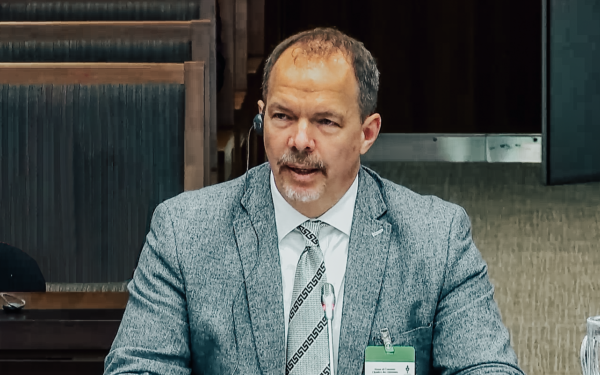CIRA is embarking on the fifth year of its Community Investment Program. Canadian not-for-profits, charities and researchers doing good things for and through the internet can apply for a CIRA grant during the application period, which launches in January. To celebrate the program’s success, we are sharing stories of past recipients who have inspired us. Read part two of the series: The First Mile Connectivity Consortium
Part 2: Serving the unserved – Shaping digital policy to support community broadband
CIRA is embarking on the fifth year of its Community Investment Program. Canadian not-for-profits, charities and researchers doing good things for and through the internet can apply for a CIRA grant during the application period, which launches in January. To celebrate the program’s success, we are sharing stories of past recipients who have inspired us through their commitment to building a better online Canada.
In 2015, the First Mile Connectivity Consortium received a grant on behalf of CIRA’s Community Investment Program to address major gap in Canada’s internet infrastructure. Some Indigenous communities are losing out on the digital economy due to a lack of affordable, accessible and appropriate internet. Despite years of government subsidies to telecommunications providers to address this problem, it persists today – and there are few private sector incentives to build, upgrade and maintain digital infrastructure. In this context, these populations established their own non-profit broadband providers. The First Mile Connectivity Consortium, a national association started by these First Nation broadband providers, developed a project to mobilize their work at a major regulatory hearing. The ultimate goal was to propose a permanent fund to sustain their work, highlight regulatory challenges to community-driven innovation in broadband infrastructure, and create and share a number of digital resources about these efforts.
We sat down with CIRA grant recipient Rob McMahon from the First Mile Connectivity Consortium and Assistant Professor in the Faculty of Extension at the University of Alberta to learn more about the impact of the Community Investment Program in developing this project.
How did you hear about CIRA and the Community Investment Program?
I’ve been aware of CIRA through the internet community for quite some time. As for the Community Investment Program, it’s difficult for me to pinpoint exactly how or when. If my memory serves me right, I got wind of the grant program through colleagues and used Google to dig a little deeper.
How important was CIRA’s grant for your project’s success?
It was very helpful!
CIRA’s support was instrumental in producing the concrete research reports, community stories, website updates, public presentations and other funded activities that helped raise our profile and further our mandate. Specifically, we used the funds to hire graduate students at the Masters and PhD level to carry out research on northern and remote communities, resulting in some amazing and engaging content.
The evidence supports our efforts to propose reforms to digital policies to better promote the innovative work being done in – and most importantly by – Indigenous communities. It supported our goal to build an inclusive network society and vibrant digital economy that reflects the digital innovations driven by Indigenous communities, including in remote, rural and northern regions.
What were some of the highlights of your project?
In April 2016, we appeared before the CRTC to intervene in the telecommunications ‘basic service’ hearings. It’s safe to say that everybody was thrilled by this opportunity. It was a chance for us to share our concerns about broadband access and affordability in rural, remote, and Indigenous communities and more importantly, to showcase and apply the work our member organizations have been doing over the years to bridge those digital divides.
The project funded us to produce two reports, which we shared with the Commission and through our website to highlight the gaps and opportunities in delivering appropriate and equitable broadband connections and services in remote and rural Indigenous communities across Canada. It also allowed us to research and write several stories highlighting First Nation innovation. The graduate students employed by the project gained valuable experience through this project, and the First Nations highlighted in the stories are pleased to see their work being recognized.
What’s even more exciting is that in December 2016 the results came out announcing that broadband is now considered an essential service, and will become more accessible to communities of concern. The decision will hopefully lead to higher speeds, more funding and no data caps. As well, the CRTC announced that it is creating a new fund to support the work of a variety of organizations – including Indigenous broadband providers – to address these deficiencies.
What were some of the challenges?
The number one challenge we faced is that in this area, everything is constantly changing.
As projects develop, often there is a disconnect between what you initially conceive and put in your proposal versus the reality of the project and the final product. As you continue to engage your community, you quickly discover that things shift and you will likely need to adapt. We learned quickly that to succeed, we needed to adopt more of an iterative approach.
How does your project contribute to a better online Canada?
A better online Canada includes digital innovation taking place in Indigenous, remote, rural, and northern communities. Innovation happens across Canada – not just in urban centers, but everywhere. Unfortunately, Indigenous communities lack affordable, accessible and appropriate internet so they are losing out on opportunities in the digital economy, and do not have equitable access to many of the online social, health, education and other services available elsewhere in Canada. However, in many cases these groups are building and managing their own solutions to these digital divides. Our project helped mobilize these groups through policy, research, and community stories. But more importantly, our project helped us display all the work they are doing.
What advice would you give organizations considering applying for a grant?
Try and plan for flexibility, recognizing how needs may shift over time and then build that into the project. This kind of engagement also helps with community uptake and sustainability. As I talk about “needs”, I also encourage future applicants to co-develop their project with the group they intend to work with. This is necessary to ensure the work they plan on doing is actually meaningful to the groups for their daily life.
Also, having a project that builds in knowledge mobilization is increasingly important. You should share the results in research papers, in blog posts and in the media. How you are communicating results is very important.
About CIRA’s Community Investment Program
CIRA is building a better online Canada through the Community Investment Program by funding innovative projects led by charities, not-for-profits and academic institutions that are making the internet better for all Canadians. CIRA is best known for our role managing the .CA domain on behalf of all Canadians. While this remains our primary mandate, as a member-based not-for-profit ourselves, we have a much broader goal to strengthen Canada’s internet. The Community Investment Program is one of our most valuable contributions toward this goal and funds projects in infrastructure, digital literacy, online services, and research. Every .CA domain name registered or renewed contributes to this program. To date, CIRA has supported 102 projects with over $4.2 million in contributions. The application period for funding opens in mid-January 2018. Visit www.cira.ca/cip to learn more.
Mackenzie Messenger specializes in corporate communications for CIRA. She has a passion for branding, internal communications and organizational learning. She also has a Master of Arts in Organizational Communication from the University of Ottawa, where she conducted research on millennials in the workplace.




